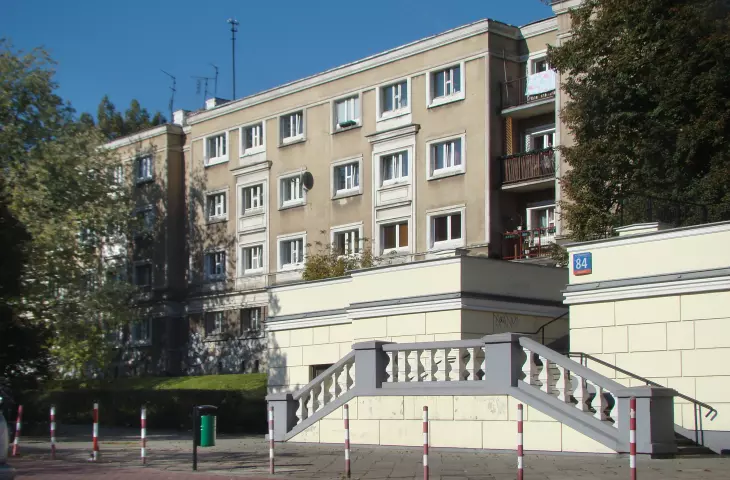The post-war Muranów Południowy neighborhood has been placed under strict conservation protection. The entry in the register of monuments is, among other things, the result of the involvement of residents, who themselves demanded that the area be placed under protection.
The entry in the register of monuments was made by Prof. Jakub Lewicki, Mazovian Voivodship Conservator of Monuments, the office announced on December 21. It encompasses the urban layout and the buildings themselves of the estate located in the Śródmieście and Wola districts, within the boundaries of Solidarności Avenue, Andersa, Nowolipie, Zamenhofa, Dzielna, Bellotti, Wolność, Żytnia and Żelazna Streets.
Muranów housing development
© public domain
The estate was built between 1949 and 1956 as the southern part of what was then an inner-city residential district. In 1948, the investor was the Department of Workers' Estates (ZOR), which entrusted the design of the housing complex on the ruins of the former ghetto to Bohdan Lachert. In addition, the team of the 11th Studio of the Department of Workers' Estates - composed of assistants, technicians and students - participated in the work. The sculpture team was headed by the rector of the Warsaw Academy of Fine Arts, Franciszek Strynkiewicz.
Muranów Housing Estate
© Mazowieckie WUOZ
Muranow's uniqueness stems from its specific location - partially overlapping with the area of the Warsaw Ghetto. Its liquidation and razing in May 1943 left a huge area of the city covered with a layer of rubble three meters thick. This was a challenge for designers - related to the movement of such large masses of materials and the lack of free land for development. There was also a lack of context to which the new design could be related - this in turn gave complete formal freedom in shaping the development. The only reference in planning was the preserved underground infrastructure and the W-Z and N-S Route under construction. Even so, the architects decided that the Muranów Południowy Estate would largely recreate the course of the streets of the former Northern District, delineated on the basis of the preserved underground infrastructure.
Characteristically for the doctrine of Socialist Realism, during whose reign the development of the housing development fell, its goal was to combine practical and ideological aspects. Modernist solutions were introduced in architecture and planning. The housing development was erected for 40,000 workers, with standards unavailable to them before the war. In addition, Muranow, erected on the ruins of the ghetto, was conceived as a place of memory - a symbolic "memorial estate." The buildings were erected on rubble mounds, and the same material was also used to erect the walls of the buildings themselves.
Muranów estate
© Mazowieckie WUOZ
The designers used the entire palette of modern housing typologies. In Muranów you will find staircases, point-blocks, galleries, skyscrapers and public buildings. Residential buildings are complemented by schools, kindergartens, nurseries and a cinema. The unique value of Muranow is the degree of its preservation - the original decorations, horizontal communication routes have been preserved. In addition, the system of composed greenery of squares, greens, street rows is fully legible.
Muranów housing estate
© Mazowieckie WUOZ
As the WUOZ points out, the historical values of the estate stem from the fact that it was built on the site of the demolished Warsaw Ghetto. The new development - rubble-concrete buildings erected on tidy rubble heaps, which were used as a base for the slopes and terraced layout of the area - constitute an "Estate-Monument" and a memorial to the tragedy of the Holocaust. Muranów Południowy was an experimental settlement and documents the development of Polish architecture in the second half of the 20th century.
The entry in the registry is also motivated by the need to protect the artistic values, both of the urban planning premise and the building complex. They result from the combination of stylistic social realism and modernist functionalism. Artistic values are represented by stylized, repetitive architectural details or decorations made in the sgraffito technique.
Warsaw 1945-1966, Warsaw Press Publishing House RSW "Prasa" and Editorial Board of "Stolica" Weekly, Warsaw 1967, p. 92.
© public domain
Muranów also meets the criteria of technical and scientific value. During the construction of the estate, new technologies such as rubble concrete blocks and prefabricated sculptural detail were implemented. This pioneering development became a permanent part of the development of architecture in the second half of the 20th century and is a testimony to, among other things, the application of urban visions of the time and post-war technologies.



































